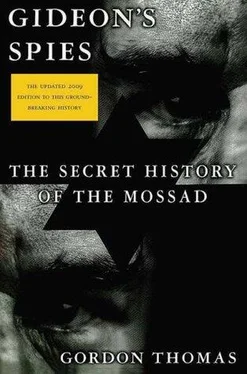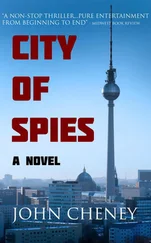Gordon Thomas - Gideon's Spies
Здесь есть возможность читать онлайн «Gordon Thomas - Gideon's Spies» весь текст электронной книги совершенно бесплатно (целиком полную версию без сокращений). В некоторых случаях можно слушать аудио, скачать через торрент в формате fb2 и присутствует краткое содержание. Город: New York, Год выпуска: 2009, ISBN: 2009, Издательство: Thomas Dunne Books, Жанр: История, на английском языке. Описание произведения, (предисловие) а так же отзывы посетителей доступны на портале библиотеки ЛибКат.
- Название:Gideon's Spies
- Автор:
- Издательство:Thomas Dunne Books
- Жанр:
- Год:2009
- Город:New York
- ISBN:978-0-312-53901-6
- Рейтинг книги:4 / 5. Голосов: 1
-
Избранное:Добавить в избранное
- Отзывы:
-
Ваша оценка:
- 80
- 1
- 2
- 3
- 4
- 5
Gideon's Spies: краткое содержание, описание и аннотация
Предлагаем к чтению аннотацию, описание, краткое содержание или предисловие (зависит от того, что написал сам автор книги «Gideon's Spies»). Если вы не нашли необходимую информацию о книге — напишите в комментариях, мы постараемся отыскать её.
Gideon’s Spies
Gideon's Spies — читать онлайн бесплатно полную книгу (весь текст) целиком
Ниже представлен текст книги, разбитый по страницам. Система сохранения места последней прочитанной страницы, позволяет с удобством читать онлайн бесплатно книгу «Gideon's Spies», без необходимости каждый раз заново искать на чём Вы остановились. Поставьте закладку, и сможете в любой момент перейти на страницу, на которой закончили чтение.
Интервал:
Закладка:
In the streets of Israel’s cities the anger grew. Brigadier Yossi Hyman, the senior paratrooper’s officer, accused the IDF of “the sin of arrogance,” while expressing his own regret that he had not better prepared his own soldiers for war. A group of reservists sent a devastating indictment of IDF commanders to the country’s defense minister, Amir Peretz. The document accused IDF officers of “chronic indecisiveness and displaying under-preparation, insincerity, and an inability to make rational decisions.” Never before had there been such an attack on Israel’s military elite.
Meir Dagan was not alone in recognizing that if Israel was to survive in an Islamic world grown more determined to remove it, it must urgently learn from its mistakes and adapt. There was a growing public demand that Olmert should resign along with some of his generals. Among those who did resign was Chief of Staff of the Israeli Defense Forces, General Dan Halutz. But the prime minister clung to office. It was only when he found a criminal investigation, alleging he had been involved in corrupt financial deals, did he finally announce he would leave office in October 2008 and fight to clear his name.
As an uneasy truce settled over Lebanon, Operation Overt, to which Mossad was one of half-a-dozen security services making a contribution, began to move to resolution. MI5 was checking all Britain’s universities and technical schools for Middle East students who had come to Britain to study thermochemistry, the science which includes creating liquid explosives. The search also extended to all British firms that had employed foreign students since 9/11. The fear was that any of them could have been recruited by one of the two terror cells now under intense surveillance in London that were now known to MI5 to be linked to al-Qaeda. MI5 were certain the plot centered on destroying transatlantic flights from Heathrow to the United States.
Mossad’s own scientists had already told MI5 the most effective way of smuggling explosive liquids onto an aircraft would be using two stable fluids which could be mixed in an aircraft lavatory to create a powerful bomb. Research by the chemists showed that nitroglycerine hidden inside a tub of hair gel or a shampoo bottle, with a detonator hidden inside a cell phone, would be one effective method. Another was to use two bottles of clear chemicals hidden inside cans of soft drinks or toiletries. A prime candidate for this method would be triacetone triperoxide (TATP) a crystalline white powder. The July 7, 2005, bombers in London had used this method to create the explosions on the city’s underground system. On board an aircraft the two chemicals would be mixed to create TATP.
Ehud Keinan, a member of the Technical Institute in Tel Aviv, whose expertise was invaluable to Mossad, said (to the author):
There are a number of ways to make liquid explosives. My guess is that terrorists would use one based on the peroxide family. This is because it is relatively easy to initiate such explosives. There is no need for a detonator and a booster. A burning cigarette or a match would be enough to set them off. The basic materials to achieve this are readily available in unlimited quantities in hardware stores, pharmacies, agricultural suppliers, and supermarkets. Sadly, most airports are not yet equipped with the appropriate means to detect those explosives. The truth is that there is no efficient way to stop a suicide bomber who carries a peroxide-based explosive on his body or in his carry-on luggage.
The Mossad chemists concluded that while it would be difficult to destroy an aircraft with one liquid-based bomb, it could be achieved by combining several bombs on one aircraft and placing them near windows or escape hatches. But even a small device could sever an aircraft’s hydraulic control cables. MI5 chemists had studied the precedents for such attacks on board an aircraft. In June 1985, Sikh militants had obliterated an Air India aircraft over the Atlantic Ocean, killing all 329 passengers. Pan Am Flight 103 had been similarly destroyed on December 21, 1998, over the Scottish town of Lockerbie. In 1995, al-Qaeda operatives planned to attack a number of passenger planes over the Pacific Ocean. One aircraft owned by Philippine Airlines was attacked with a nitrocellulose bomb, which killed one passenger and injured ten others. On December 22, 2001, Richard Reid, a British-born follower of Osama bin Laden, tried to destroy American Airlines Flight 63 as it flew from Paris to Miami. He had explosives stuffed in his shoes.
The details of all these acts were on the screens in the Joint Terrorism Analysis Centre in London. At 10:30 on a warm Sunday night in August, the red light on the senior duty officer’s desk blinked. The caller was Eliza Manningham-Buller, head of MI5. Moments earlier she had been told that four months of a patient and top-secret investigation by MI5, MI6, the CIA, Mossad, and Pakistan’s intelligence service was about to reach its climax. John Scarlett, the head of MI6, had just received a “flash” encrypted e-mail from a field agent in Karachi. Pakistan intelligence had confirmed that al-Qaeda was about to launch a series of attacks on British and American transatlantic flights from Heathrow. It was the moment the greatest terrorist threat Britain had ever faced brought JTAC to “full operational mode.” In rapid succession, Tony Blair was alerted. He contacted President Bush. By then key officials in Cobra, the government crisis team, were being briefed. So was Sir Ian Blair, Britain’s top policeman. Airline chiefs and other authorities, including the director of security for the Channel Tunnel, were also alerted. All the heads of foreign intelligence were told. By then the Anacapa charts were filling, the center’s plasma screens were alive with data, and the phones blinking furiously. Over the next six days, into and out of the work stations—each equipped with state-of-the-art communications systems—information flowed. Intelligence—once only shared with the CIA, French, and German security services—was exchanged with other services. The question all urgently needed to answer was: had they picked up even “a whisper in the wind” of when the plot to destroy the airliners would happen? From Rome came the first hint. SIMSI, the Italian secret service, said they had a large number of terror suspects under surveillance. One had admitted the attack would come “very soon.”
Porton Down’s experts were called upon to decide what kind of liquid explosive would be used. Around the clock, surveillance reports continued to come to the work stations. In between long days and nights, men and women catnapped in a nearby dormitory in the basement. One report was from an MI5 undercover team near a house in High Wycombe in Buckinghamshire. Other teams reported from south London and Birmingham. GCHQ specialists analyzed phone intercepts from suspect houses. In communities where the suspects lived, MI5 had set up other sophisticated surveillance sites. Some of the suspects had become assimilated into British society, but had made regular trips to relatives in Pakistan and elsewhere. Pakistan’s intelligence service had provided JTAC with details. The suspects were known as “Trojans,” JTAC-speak for those who may have been recruited to become home-grown terrorists. Their cell phones were bugged. Their every movement noted. Radio waves bounced off windowpanes to monitor conversations in a room they occupied. The latest technology filtered through thousands of e-mails. The surveillance teams’ information was studied by a JTAC lawyer to ensure their findings would be admissible in court.
Seventy-two hours later sufficient information had been gathered for arrests to go ahead. Twenty-two people were taken into custody. They included a convert to Islam and a seventeen-year-old youth. But in JTAC the work continued to establish the full extent of the plot. Scotland Yard predicted it could possibly be a year before the suspects were brought to trial.
Читать дальшеИнтервал:
Закладка:
Похожие книги на «Gideon's Spies»
Представляем Вашему вниманию похожие книги на «Gideon's Spies» списком для выбора. Мы отобрали схожую по названию и смыслу литературу в надежде предоставить читателям больше вариантов отыскать новые, интересные, ещё непрочитанные произведения.
Обсуждение, отзывы о книге «Gideon's Spies» и просто собственные мнения читателей. Оставьте ваши комментарии, напишите, что Вы думаете о произведении, его смысле или главных героях. Укажите что конкретно понравилось, а что нет, и почему Вы так считаете.












